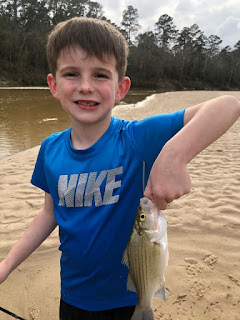Known as Sand Bass, Barfish, Streaker, or Silver Bass, the White Bass has become a favorite target of freshwater anglers, including fly anglers, in Texas. Here is Texas Freshwater Fly Fishing's Fish Spotlight on one of the Texas' favorite Springtime catches.
Fish Spotlight: White Bass
Appearance
The scientific name, Morone chrysops, means "golden eye" after the yellowish appearance of the White Bass' eyes. But the most recognizable characteristic of where White Bass get their name is from the fishes coloration. White bass are similar in appearance to to both their saltwater (or really, anadromous) cousins, the Striped Bass, and the hybrid of the two, the Hybrid Bass (aka Wiper.) They have silvery, white sides that are darker, often olive, toward the top and almost pure white on the belly. They typically have between 6 and 10 incomplete lines that run down both sides of the fish. These lines can be an olive brown in color. Helping to distinguish between White Bass and their cousins, these lines are usually less prominent on White Bass than on Striped Bass. Other ways to distinguish between white bass, hybrids, and stripers, include the shape of the body (white bass are deeper bodied), the points on the gill plate (White Bass have one, Striped Bass have two), and a toothpatch on the back of the tongue (White Bass have one patch, Striped Bass and Hybrids have two.)
 |
| Photo courtesy of Kenley Crowe |
A typical White Bass is between 8 and 12 inches in length, but they can grow longer. The Texas state records are as follows: The conventional tackle record is 5.56 lbs and 20.75 inches in length, caught by David Cordill in the Colorado River on March 31, 1977. The state fly fishing record White Bass stands at 3.36 lbs and measured 16.5 inches. It was caught on April 6, 1999, in Richland-Chambers Reservoir, by Billy Autery, on a white wooly-grubber (yes I had to look that fly up, maybe I'll do a Tuseday Tie on it.)
 |
| Photo courtesy of Chris Morton |
Behavior
Late Winter and early Spring (Late Feb through March) in Texas tends to be the time of year that fly fishermen will really target White Bass, and this has almost everything to do with their spawn. In the late winter, typically January and February, White Bass will start to congregate and school up in the upper ends of our reservoirs, near where rivers and creeks flow in. Soon after, depending on inflows from these tributaries, the males will start to move upstream into these flowing waters, followed by the females. These White Bass that "run" up the rivers to spawn can travel upwards of 50 miles, depending on the conditions, to spawn.
 |
| Photo courtesy of John McDonald |
White Bass do not spawn on beds, they will spawn in open flowing waters. The females will rise up into the males, triggering the males to surround her as they release their eggs (often almost a million egges) and sperm. The now fertilized eggs will fall to the bottom, attach to rocks and in 2 or 3 days, the fry will hatch. Soon the fry will migrate downstream, schooling up, feeding, and growing rapidly (around 8 inches in the first year alone.)
This spawning run into the rivers and streams provides for what can be a fast and furious fishing experience for fly anglers. However, the success and timing of this run can vary depending on conditions, mostly the inflow of freshwater, from year to year.
 |
| Photo courtesy of Greg Yows w/Greg Welender of Upstream on the Fly |
Distribution
Although White Bass are common in many Texas rivers and reservoirs today, the only place they are native in Texas is the Red River Drainage system. They are native to the Central portion of the United States (west of the Application Mountains.)
Prior to 1932, the only water you could find them in in Texas was Caddo Lake. However, in 1932, Texas Game, Fish, and Oyster Commission, took 13 fish from Caddo Lake and stocked them into old Lake Dallas (now part of Lake Louisville.) With that stocking attempt being successful, then then went on and stocked White Bass into Lake Kemp, Lake Buchannan, Medina Lake, Eagle Mountain, Lake Waco, and Lake Wichita, in 1938.
White Bass populations grew in these reservoirs and in others, and they have become a regular fish in many (most) reservoirs in Texas. According to records, the last stocking of White Bass by Texas Parks and Wildlife was done in 2016, when they stocked 60 adult White Bass into Lake E. V. Spence. The last stocking of real significant numbers was in Falcon Reservoir in 2009, when TPWD put in 1,162,094 White Bass Fry.
 |
| Photo courtesy of Julia Hopson Bell |
So head our this spring with some minnow and shad imitation flies and go catch you a mess of White Bass.


Comments
Post a Comment